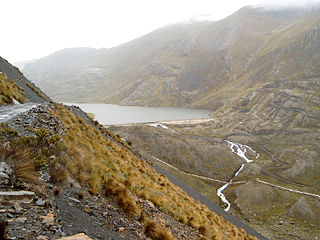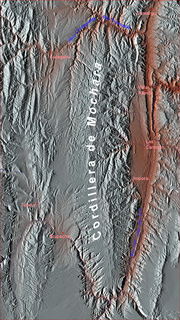
Inkallaqta is a monumental Inca site in central Bolivia. It is located in the Cochabamba Department, Carrasco Province, Pocona Municipality, approximately 130 kilometers east of Cochabamba. It was most recently excavated by Larry Coben.He believes that the site was used to perform rites for the ceremonial calendar. The site has several important structures such as the Kallanka. It was the largest single roofed room in the western hemisphere when it was built, and measures 78 by 25 meters. There's also an ushnu or a ritual platform on the site. The Torreon of Inkallaqta is also located on this site. Located at the western side of the site this six sided structure supposedly had calendrical or astronomical significance. There is a zigzag wall immediately north of the site which is meant to mark and protect it.
Inka Wasi or Inkawasi may refer to:

Incahuasi District or Inkawasi is one of six districts of the Ferreñafe Province in the Department of Lambayeque in Peru.
Isla Incahuasi, Inkawasi or Inka Wasi is a hilly and rocky outcrop of land and former island in Bolivia situated in the middle of Salar de Uyuni, the world's largest salt flat, at an elevation of 3,656 meters. It is located in the Potosí Department, Daniel Campos Province, Tahua Municipality, Yonza Canton. Isla Incahuasi is the Spanish name where isla means island, Inca stands for Inca, and huasi is derived from the Quechua word wasi meaning house.
The Santa Elena River is a river of Bolivia in the Chuquisaca Department, Nor Cinti Province, partly on the border of Inka Wasi Municipality and San Lucas Municipality. It is a right affluent of the upper Pillku Mayu.

Iñaq Uyu, also called Aklla Wasi, is an archaeological site in Bolivia situated on the Isla de la Luna, an island of Lake Titicaca. It is located in the La Paz Department, Manco Kapac Province, Copacabana Municipality In Incan society, the societal structure was very rigid. Often those of belonging to the royal class structure did not mix with the lower classes.

Inkachaka Dam is a dam in Bolivia situated in the La Paz Department, Pedro Domingo Murillo Province, La Paz Municipality, north east of La Paz.

Incahuasi or Incawasi is an archaeological site in Peru. It is located in the Lima Region, Cañete Province, Lunahuaná District.

Inka Wasi or Inkawasi is an archaeological site in Peru. It is located in the Ayacucho Region, Parinacochas Province, Pullo District.

Inka Wasi is an archaeological site in the Huancavelica Region in Peru. The Inca palace is considered one of the most important monuments of the Huancavelica Region. Inka Wasi is located in the Huaytará Province, Huaytará District, about 25 km from Huaytará. It is situated at a height of 3,804 m (12,480 ft).
Inka Raqay or Inkaraqay is a small archaeological complex in Peru. It lies in the Apurímac Region, Abancay Province, Cachora District. Inka Raqay is situated at a height of 3,590 metres (11,778 ft) on the northern slope of Inka Wasi south of the archaeological site of Choquequirao, above the Apurímac River.

Inka Mach'ay is an archaeological site in Bolivia. It is situated in the Chuquisaca Department, Oropeza Province, Chuquisaca Municipality, at a height of 3,510 metres (11,516 ft). Inka Mach'ay was declared a National Monument on May 27, 1958, by Supreme Decrete No. 4954.

Amaru Marka Wasi, Amarumarcahuasi or Amaromarcaguaci also known as hispanicized and mixed spellings , Amarumarkahuasi, Amaru Markahuasi), Salunniyuq(Salonniyoq, Salonniyuq), Salunpunku(Salonpunku), Laqu, Laq'u(Lacco, Lago), or Templo de la Luna is an archaeological site in Peru. It is situated in the Cusco Region, Cusco Province, Cusco District, north of the city of Cusco. It lies east of the archaeological site of Sacsayhuamán and south of Tambomachay and Puka Pukara, near Qenko.

Incahuasi is a mountain in the Vilcabambamountain range in the Andes of Peru whose summit reaches 4,315 metres (14,157 ft) above sea level. It is situated in the Apurímac Region, Abancay Province, Cachora District. The mountain lies on the bank of the Apurímac River, opposite the archaeological site of Choquequirao. On its northern slope there is a small archaeological site named Inka Raqay. Tourists are also attracted by the viewpoint of Incahuasi which provides good views of the Apurímac valley, Choquequirao and Padreyoc.
Inkachaka or Inka Chaka is an archaeological site in Bolivia. It is situated in the Cochabamba Department, Chapare Province, Colomi Municipality. The site was declared a Cultural Heritage of Bolivia by Law 2533 on October 24, 2003.

Inka Wasi is a mountain in the Andes of Peru, about 4,400 metres (14,436 ft) high. It is situated in the Ayacucho Region, Lucanas Province, Cabana District. It lies south of Anqasi and northeast of Misapata.

Inka Pukara is a 4,422-metre-high (14,508 ft) mountain in the Bolivian Andes. It is located in the Cochabamba Department, Arque Province, Tacopaya Municipality, southeast of Tacopaya.

Inka Q'asa is a mountain in the Bolivian Andes which reaches a height of approximately 4,160 m (13,650 ft). It is located in the Cochabamba Department, Ayopaya Province, Morochata Municipality. The Ch'uya Mayu originates west of the mountain. It flows to the west as a left tributary of the Río Negro.

Inka Wasi is a 3,146-metre-high (10,322 ft) mountain in the Bolivian Andes. It is located in the Chuquisaca Department, Azurduy Province, Tarvita Municipality. Inka Wasi lies southwest of Muyu Urqu and north of Pukara. The Laqha Mayu originates north of the mountain. Its waters flow to the Pillku Mayu.














